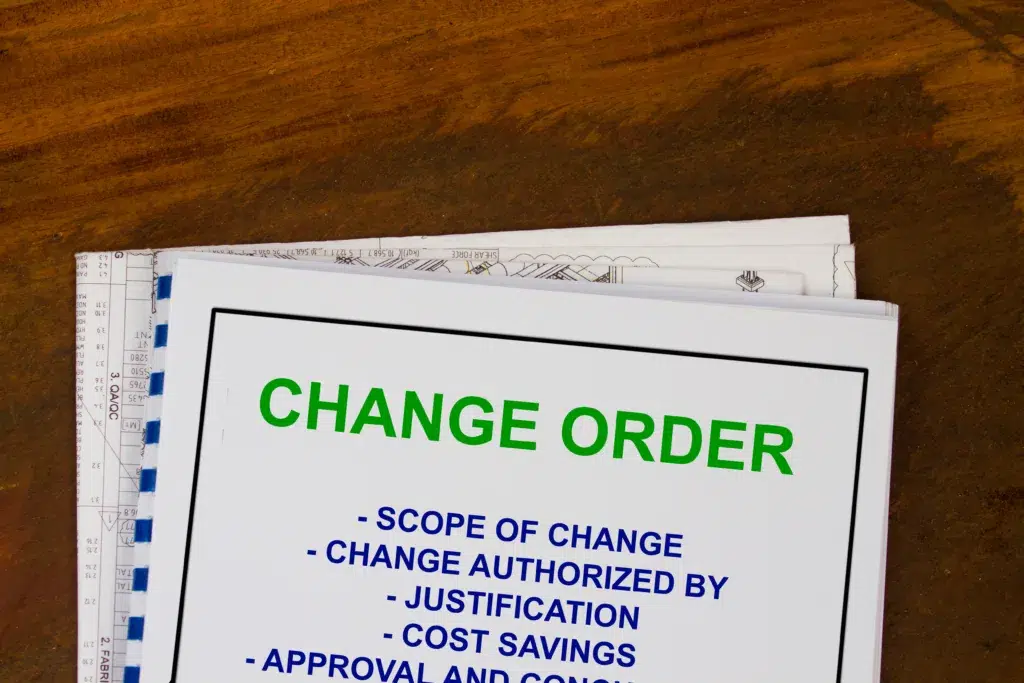This article will discuss frequently asked questions about construction change orders. For those who want clarity around construction change orders, this article is for you. I hope my answers to these questions help clarify this topic.
Table of Contents
What is a construction change order?
A change order in construction refers to an official modification to the initially agreed-upon contract. This document outlines necessary adjustments in the project’s work scope, budget, and timeline.
Typically, the original construction contract outlines the procedure for implementing change orders. It includes detailed instructions on handling and executing these changes efficiently.
Change orders have significant implications for a construction project. They not only modify the project’s scope and timeline but also impact a contractor’s responsibilities and financial compensation.
Who writes and initiates the change orders in construction?
In construction projects, change orders are typically written and initiated by various parties depending on the nature and scope of the change. Here are the key roles involved:
- Project Manager: The project manager often drafts and writes change orders. They oversee the project and ensure that changes are well-documented, justified, and communicated to all relevant parties.
- Architect or Engineer: For changes that affect a project’s design or engineering aspects, the architect or engineer writes the change order. This ensures that any technical specifications are accurately reflected.
- Contractor or Subcontractor: In some cases, especially for smaller changes or those directly related to the construction work, the contractor or a subcontractor might draft the change order. This is common for changes that involve construction methods or material substitutions.
- Owner or Owner’s Representative: For changes initiated by the project owner, the owner or their representative (like a construction manager) drafts the change order. This often occurs when the owner wants to alter the scope or specifications of the project.
Regardless of who writes the change order, it must be reviewed and approved by all relevant parties, including the owner, architect/engineer, subcontractor, and contractor. This ensures everyone agrees on the change’s scope, cost, and impact. The change order becomes a formal part of the construction contract once the necessary parties sign it.
What is the average cost and fee of a construction change order?
The average cost of a construction change order can vary significantly based on various factors such as the size and scope of the project, location, materials used, and the nature of the changes requested. Typically, a markup of 10% on the direct net cost is deemed a fair and standard fee for change orders in construction. However, this is a general estimate, and the actual cost can be higher or lower depending on the specifics of each project.
For example, a slight change in a residential project might cost a few thousand dollars, whereas a significant change in a large commercial project could amount to millions. It’s important to note that effective project management and clear communication between all parties involved in a construction project can help minimize the frequency and cost of change orders.
Why are there so many change orders in construction?
Change orders in construction are common due to various reasons, such as unforeseen site conditions, changes in client requirements, regulatory changes, availability of materials, errors in initial planning, contractor suggestions for improvements, and safety concerns. There are just so many factors that can change during the construction project and are difficult to predict. That’s why there are lots of change orders in construction.
When Do Change Orders Occur?
Change orders often arise when a client changes or introduces new concepts to the already established plans. Alternatively, contractors might trigger a change order if they foresee potential issues during the project’s progression or if their initial cost assessments were inaccurate. Additionally, external factors beyond the control of either party can necessitate change orders. These may include unforeseen site-specific challenges like hidden obstructions uncovered during work commencement or supply chain disruptions affecting material availability. In addition, problems with project design, such as incorrect specifications, often become apparent only after the construction process has begun, leading to the need to make changes.
When should you ask for a change order in construction?
In construction, it’s advisable to request a change order whenever there’s an alteration in the project’s defined scope as outlined in your contract. This ensures that any modifications are formally acknowledged and agreed upon. Importantly, obtaining the property owner’s signature on this change order is crucial for validation and future reference. This process helps maintain clear communication and avoid misunderstandings related to project scope and expectations.
What is a change order proposal in construction?
A change order proposal or request is a structured, official document submitted by an employee, contractor, subcontractor, or client requesting alterations to a project’s original plans, specifications, or scope. This type of request is commonly seen in sectors such as construction and manufacturing and plays a critical role in managing project modifications. It facilitates assessing and negotiating these modifications while ensuring transparent communication among all involved parties.
This document typically contains a comprehensive description of the suggested modification, its rationale, and its potential impact on the project’s timeline, budget, and resources. It is a foundation for initiating discussions about the necessity, feasibility, and acceptability of the proposed change.
Once the change order proposal or request is thoroughly reviewed and assessed, it may be approved, modified, or declined. Approval of the request leads to the issuance of a formal change order.
What is a subcontract change order? Understanding Subcontract Change Orders (SCOs/SubCOs).
Subcontract change orders, commonly called SCOs or SubCOs, are vital tools in construction project management used to document modifications to existing subcontracts. These changes can originate from either the general contractor or the subcontractor and often impact a subcontract’s financial and temporal aspects.
The primary reason to issue a subcontract change order is when the subcontract’s scope shifts. This could involve additions or reductions to the previously agreed-upon items or the introduction of entirely new scope items. It’s important to note that while the subcontract subject to change must be approved, it doesn’t need to be integrated with the project’s accounting modules.
In practice, the subcontract change order process follows a structured path. Initially, a change proposal request (CPR) is submitted, which may lead to or coincide with a Change Order (CO) process. Once these steps are completed, the general contractor formally reviews and approves the subcontract change order. This procedure ensures that any adjustments to the subcontract are officially recognized, documented, and agreed upon by the relevant parties, thereby maintaining the integrity and smooth progression of the overall project.
What is an example of a change order in construction?
Here are a couple of examples of change orders that occur in construction projects:
- Change in Project Scope: The client decides to add an additional room to a building project. This change would impact the project’s cost, materials needed, timeline, and structural design.
- Material Substitution: Due to the unavailability of the originally specified materials or a change in the client’s preference, alternative materials might be used. For example, they are choosing a different type of flooring or another brand of fixtures.
- Design Modifications: After the construction has begun, the client might want to change the design of a particular element, such as the room layout, window sizes, or the type of roofing.
- Unforeseen Conditions: During the construction process, unforeseen issues such as soil problems, hidden structural defects in existing buildings, or environmental concerns might arise, necessitating changes in the construction approach.
- Timeline Adjustments: A client or contractor might need to extend or shorten the project timeline due to various factors like budget constraints, weather conditions, or delays in material delivery.
How to Prepare for Construction Change Orders
Preparing for change orders in a construction project involves several key steps:
- Acknowledge the Inevitability of Changes: Start with the understanding that most projects will undergo changes. This mindset prepares you and your team for adaptability.
- Incorporate Change Order Processes in Contracts: Ensure that your construction contract explicitly outlines the process for handling change orders. This should include the steps for drafting, amending, agreeing upon, signing, and executing change orders.
- Use Automation Software: Implement software tools, like Bauwise, that automate the change order process. This technology can track each step, ensuring efficiency and transparency.
- Empower Project Managers: Ensure that project managers have the skills and knowledge to:
- Clearly communicate the necessity of changes.
- Explain why changes are needed.
- Discuss the potential impact of these changes on the project.
- Provide accurate cost estimates for the changes.
- Effectively convey all this information to their teams and other key stakeholders.
By following these steps, a construction firm can manage change orders effectively, maintaining the project’s momentum and minimizing disruptions.
Are change orders good or bad?
Change orders in a construction project can be both good and bad, depending on various factors:
Good Aspects of Change Orders
- Addressing Unforeseen Issues: They allow for adjustments when unexpected problems or needs arise that were not accounted for in the original plan.
- Improving Project Outcomes: Change orders can lead to enhancements in the project, resulting in a better final product or service.
- Flexibility: They provide a mechanism for adapting to changes in client needs, market conditions, or regulatory requirements.
- Documenting Changes: Change orders offer a formal process for documenting and approving changes, ensuring clarity and agreement among all parties involved.
Bad Aspects of Change Orders
- Cost Overruns: They often lead to increased costs, which can strain budgets and financial planning.
- Project Delays: Implementing changes can cause delays in the project timeline, affecting overall project scheduling and deadlines.
- Scope Creep: Frequent or poorly managed change orders can lead to scope creep, where the project continually expands beyond its original objectives.
- Client-Contractor Conflicts: They can sometimes lead to disputes between clients and contractors over the necessity, cost, or impact of the changes.
Whether change orders are beneficial or detrimental depends on how they are managed and the project’s context. They are a necessary and inevitable part of most projects, but their impact can vary widely.
Do Contractors Typically Budget for the Cost of Change Orders in Construction?
Based on the information provided and industry knowledge, it is evident that contractors typically do budget for the cost of change orders in construction projects. Recent studies indicating that about 40% of construction projects experience change orders resulting in a 5 to 10% increase in the total project cost highlight these changes’ frequency and financial impact.
In response to this reality, both owners and contractors generally incorporate the potential costs of change orders into their initial budgeting and contract planning. This proactive approach involves setting aside additional funds, often recommended to be around 15% of the total project budget, to account for possible changes or unforeseen conditions that might arise during the construction process.
This allocation of extra funds is a strategic move to ensure the project can adapt to changes without severely impacting its overall financial stability. It reflects the industry’s understanding that change orders are a common occurrence and need to be planned for financially to maintain the project’s feasibility and sustainability.
Why would you reject a change order?
To reject change orders involves declining proposed amendments and adhering to the initial project plan. This approach offers several advantages, such as preserving the project’s original scope, timeline, budget, and quality. It helps to avoid unnecessary modifications or disruptions and safeguards your interests and rights. Nonetheless, rejecting change orders comes with certain risks. These include losing the client’s trust or satisfaction, missing out on possible enhancements or opportunities, and facing legal or contractual setbacks. If you decide to reject change orders, it is important to base your reasoning on the project objectives, scope statement, contractual agreement, or change management strategy. In addition, it is important to clearly and respectfully communicate your decision to the person requesting the change.
Streamline your change orders with Bauwise change order management software
Bauwise offers user-friendly change order software that simplifies collecting, tracking, processing, and approving change orders. With its intuitive interface, you can easily create, modify, and manage change orders, ensuring that all modifications are accurately documented and efficiently processed. The software provides real-time updates and alerts, keeping all stakeholders informed and aligned when it is time to review and approve change orders. Try Bauwise for free today!
Written by

Taavi Kaiv
Taavi Kaiv is a construction specialist with over ten years of experience in the construction industry. Taavi is an accomplished construction project manager with many successful projects that have been completed under his guidance. Taavi holds a master’s degree in construction management from the Tallinn University of Technology. View profile
Related content
Read our articles where you can find useful and relevant information about construction change orders:





